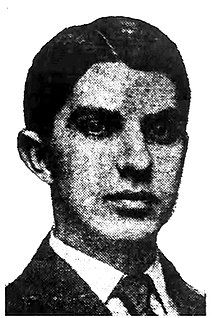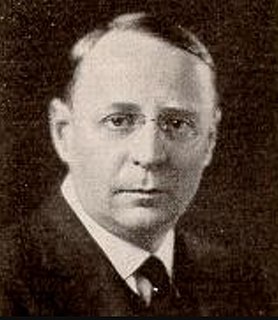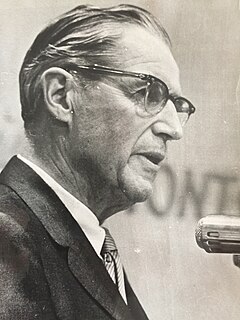Related Research Articles
The Henry Laurence Gantt Medal was established in 1929 by the American Management Association and the Management section of the American Society of Mechanical Engineers for "distinguished achievement in management and service to the community" in honour of Henry Laurence Gantt. By the year 1984 in total 45 medals had been awarded.

Henry Laurence Gantt, A.B., M.E. was an American mechanical engineer and management consultant who is best known for his work in the development of scientific management. He created the Gantt chart in the 1910s.
William Beverly Murphy was an American food businessman. He was the president and CEO of Campbell Soup Company between 1953 and 1972. From 1942 to 1945 he was on leave from Campbell's Soup to the War Production Board. Prior to joining Campbell's Soup he was at the A.C. Nielsen Company (1928–1938) where he is credited with conceiving the idea for the Nielsen Food Index and Nielsen Drug Index Services. Murphy was also a life member emeritus of the MIT Corporation.
John T. Diebold. An American businessman who was a pioneer in the field of automation, founding The Diebold Group, Inc. to advise corporations around the world as well as governments in the U.S and abroad in the potential of information technology.
Richard James Duffin was an American physicist, known for his contributions to electrical transmission theory and to the development of geometric programming and other areas within operations research.

Henry Wallace Clark was an American consulting engineer, known for popularizing the work of Henry Gantt with his 1922 work "The Gantt chart; a working tool of management".

Horace Bushnell Cheney was an American administrator, who was general manager and vice-president of Cheney Brothers Silk Manufacturing Company, in the nowadays called Cheney Brothers Historic District.
Lawrence Asa (Larry) Appley was an American management specialist and organizational theorist, known for his early work on management and organization, especially quality management. In 1962 he was awarded the Henry Laurence Gantt Medal.
Arthur Howland Young was an American engineer, vice president of U.S. Steel, lecturer at the Harvard Graduate School of Business Administration and the California Institute of Technology, pioneer of management-labor relations, and recipient of the Henry Laurence Gantt Medal in 1933.

William Loren Batt was an American mechanical engineer, and president SKF Industries, Inc., awarded the Order of Vasa in 1923, the Henry Laurence Gantt Medal in 1940, and the Hoover Medal in 1951.
Paul Eugene Holden was an American mechanical engineer, and Professor of Industrial Management at the Stanford Graduate School of Business, who was awarded the 1941 Henry Laurence Gantt Medal for his contributions to management.

Charles Ruffin Hook Sr. was an American industrialist, second president of Armco Steel Corp., and recipient of the Henry Laurence Gantt Medal in 1950.
Thomas Roy Jones was an American industrialist and management author, known as business school graduate, company president, and recipient of the Henry Laurence Gantt Medal in 1951.

Frank Henry Neely was an American mechanical engineer, consulting engineer, and President of Rich's Department Store in Atlanta. He is known for his civic activities in Atlanta, and as recipient of the Henry Laurence Gantt Medal in 1952.
Thomas Elliott Millsop was an American corporation executive, chairman and chief executive officer of National Steel Corporation, and recipient of the Henry Laurence Gantt Medal in 1952.

Henning Webb Prentis Jr. was an American industrialist, known as president of the Armstrong Cork Company, president of the National Association of Manufacturers, and recipient of the Henry Laurence Gantt Medal in 1956. In the 1940s, he described the “Prentis Cycle”, according to which popular self-governance leads people from bondage to abundance and back to bondage.

Harold Francis Smiddy was an American engineer, business manager, and management consultant, known as the 17th president of General Electric, and recipient of the Henry Laurence Gantt Medal in 1957.

Harold Bright Maynard was an American industrial engineer, consulting engineer at the Methods Engineering Council, and management author. He is known as the "Broadway counsel for industries, railroads, state governments" and as recipient of the Henry Laurence Gantt Medal in 1964.

Robert Elton Brooker was an American business executive at Sears, Roebuck & Co., Whirlpool Corporation, and Montgomery Ward, and recipient of the 1972 Henry Laurence Gantt Medal.
David William Rowsen Morgan was an American mechanical engineer and business executive at the Westinghouse Electric Corporation, known as 74th president of the American Society of Mechanical Engineers in the year 1955-56.